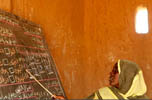
As the coordinator for Darfur Dream Team Sister Schools program, I recently traveled to eastern Chad with Enough senior advisor Omer Ismail to conduct a rapid assessment in Djabal and Goz Amer, twin refugee camps located near the town of Goz Beida in eastern Chad. We spoke to Darfuri refugee populations, including sheiks, elders, parents, and youth, about the life and conditions in the camps. We also had in-depth discussions about the humanitarian emergency needs in the refugee camps with U.N. officials and various non-governmental organizations such as INTERSOS, Jesuit Refugee Service, or JRS, Oxfam Intermon, and HAIS, the Hebrew Immigrant Aid Society.
All the humanitarian organizations are actively collaborating to fulfill the dire humanitarian needs in the camps; however, the humanitarian-development gap continues to grow. Although UNCHR and its partners initially envisioned their humanitarian response to the crisis in Darfur to be a short-term endeavor, the Darfuris have now lived in the refugee camps for the past six years and require more than just short-term humanitarian assistance. The Darfuri refugees are in desperate need of access to educational and income-generating opportunities.
Health and education continue to be two of the most ill-funded sectors by donors. A UNHCR nutrition survey conducted in January 2009 found that 12.3 percent of refugees were severely malnourished. The education sector in the Darfuri refugee is facing a similar uphill battle. For example, in Djabal and Goz Amer, the ratio of students per class is 85:1 and 93:1, respectively. The school infrastructure is dilapidated and in need of repair. Furthermore, although school enrollment is high, the dropout rate is increasing each year, especially for girls. From our discussions with the refugees and humanitarian organizations alike, we have aggregated a top five list of reasons for the continued rise in the primary school dropout rates:
Top five reasons for the rise in the high school dropout rate
- Young Darfuri girls are required to assist their families at home with chores such as cooking, cleaning, and taking care of the elderly. Darfuri girls also get married at a young age so girls disappear more quickly than boys from the school system in the refugee camps.
- Recruitment and conscription of young boys by rebel groups and the army. Rebel groups move freely within the camps and weapons are readily available. Oure Cassoni Camp located near the Sudan border has the highest boys drop-out rates because of the large Justice and Equality Movement (JEM) presence in the area.
- Lack of accesses to secondary education causes young Darfuris to become disillusioned with the education system. The Darfuri refugees only have access to distance learning offered by the Jesuit Refugee Services (JRS). The Darfuris that complete the JRS program receive a certificate that is only accepted by handful of Arabic universities in Sudan.
- The incentive to make money and gain respect in the community. Like other teenagers around the world, young Darfuris want to earn a little pocket money for personal expenses.
- The caliber of education in the camps is presently fairly low. Some Darfuri refugee parents do not see value-added from the type of education provided in the primary schools. Students are also not motivated to attend the primary schools because the certificates they receive are not accepted by all school systems in Chad and Sudan.
Check out a slideshow of photos from the camps here.

